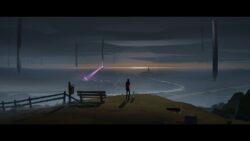Somerville – there’s less inside this one (pic: Jumpship)
From the co-founder of Inside and Limbo developer Playdead comes a new studio and a new game, featuring an unusual take on alien invasions.
The move from 2D to 3D was one of the most important milestones there’ll ever be for video games, but it meant that for a decade or more afterwards, anything that took place in just two dimensions was dismissed as old-fashioned and backwards. It took until the rise of indie gaming for that argument to be dismissed but nowadays there are many indie games that can afford to be in 3D if they want to, which raises lots of interesting questions about how best to present an idea.
What’s changed in recent years is the rise of the ‘super indie’ game, which has taken on the role of the previously extinct AA game – something like Stray, that’s much lower budget than a blockbuster AAA but still more than a typical indie title. This means that indie games no longer have to be 2D out of necessity, as they contend with less in the way of monetary and technological limitations.
Since this is the new game from the executive producer of Limbo and Inside, the decision has been taken to expand the same style of side-scrolling puzzle platformer into something more expansive, where you can move into the screen as well as along it. It seems like the next, logical step forward but the surprising thing about Somerville is how much of the magic is lost as a result.
Limbo and Inside had the same developer, and a broadly similar style of gameplay, but there weren’t any other connections between them. Naturally that’s also true of Sommerville, but the visual style is reminiscent of Inside and, like both games, there’s no dialogue at all. The nature of the puzzles is different and yet it all fits together into a trilogy of like-minded games (original developer Playdead have previously suggested that their next game is a ‘lonely sci-fi game’ that will try to escape from the ‘limitations in 2D games’ but whether this is that same idea is unclear).
Somerville is certainly sci-fi, as it opens with a very ordinary family having their evening ruined by an alien invasion. Cars are blown up, basements are fled to, and the father figure ends up being gifted with a weird alien power that can liquify the material the alien craft are made of.
It transpires that there are three such powers – colour coded to blue, red, and purple – which you eventually gain during the course of the game. The red power hardens alien objects and the purple one attracts or repels them, although in order to use the abilities you have to energise the light hitting them with your now magically (well, it’s probably nanobots or something) enhanced arm, so it’s not quite as simple as waving your hand and it’s done.
That said, the puzzles aren’t really that difficult and while some are quite clever, when you’re trying to angle light sources to point where you need them, the only real difficulty comes from frequent camera frustrations. Indie games beginning to use 3D more is all very interesting, but Somerville repeats mistakes most AAA games solved 20+ years ago, especially the one where you enter an area with a different camera angle and suddenly left is right and you end up accidentally walking straight back where you came from.
These are schoolboy errors at this point and the game is filled with other design flubs that quickly begin to make the move to 3D seem like a mistake. The game gets very finicky about exactly what spot you have to stand in to trigger an event, including something as simple as opening a door; sometimes it decides that you have to move along a 2D plane after all or that tiny physical obstacles, that could clearly be climbed over, are somehow going to keep you from your wife and child.
The visuals are all very moody and intense, but the angular graphics are also strangely reminiscent of Amiga classic Another World (aka Out Of This World). This must be intentional, as it’s the first thing we thought of on seeing the game, and since both titles have similar, silent protagonists we can only assume that Delphine’s groundbreaking classic was a major influence on Playdead, and now new studio Jumpship.
Somerville – light is very important to the puzzles (pic: Jumpship)
Another influence seems to be Steven Spielberg’s War Of The Worlds movie, except a version with the sound turned down. Not only does no one ever speak, or scream or yell, but the sound effects are very understated and seem completely at odds with the often apocalyptic visuals. The tone Somerville takes for the story is completely wrong and it almost feels as if two different teams were working from opposite ends of the game, and both had no idea what the other was doing.
Not only is the presentation a tonal mismatch but the puzzles aren’t as interesting as before and neither is the narrative. It really is just an alien invasion story, with little in the way of subtext or greater meaning. People are still arguing over what Inside is really about now, but Somerville’s themes of family and loneliness are much more straightforward.
There’s an interesting decision at the end (the game barely lasts more than three hours) that gets into the question of using fantasy and illusion to make up for heartbreak and strife but, again, it’s not terribly profound or open to interpretation – even if the ending attempts to be coy about what’s really happening.
Somerville is basically Inside but without the mystery and while that may seem appealing for those that found Inside’s narrative to be too opaque, having nothing to question in Somerville leaves the whole experience feeling empty. It’s still an enjoyable way to spend an evening, if you’re getting to play it free on Game Pass, but you’re unlikely to still be thinking about it later; not in the way the previous games got inside your head.
Somerville review summary
In Short: A disappointing follow-up to Limbo and Inside that lacks the same complexity of plot and puzzles, and yet struggles surprisingly poorly with the move to 3D.
Pros: The graphics look great and some of the puzzles are clever, even if they’re not very hard to figure out.
Cons: Very easy puzzles that are only made difficult by fiddly controls and camera issues. The visuals and sound design often seem at odds with the plot and concept. Very short.
Score: 5/10
Formats: Xbox Series X (reviewed), Xbox One, and PC
Price: £22.49
Publisher: Jumpship
Developer: Jumpship
Release Date: 15th November 2022
Age Rating: 7
Email [email protected], leave a comment below, and follow us on Twitter.
MORE : Limbo studio’s next game will be an open world sci-fi adventure and probably very creepy
MORE : Epic Games to publish new games by The Last Guardian, Limbo, and Control developers
MORE : Inside PS4 review – out of Limbo
Follow Metro Gaming on Twitter and email us at [email protected]
For more stories like this, check our Gaming page.
From the co-founder of Inside and Limbo developer Playdead comes a new studio and a new game, featuring an unusual take on alien invasions.





